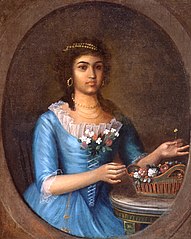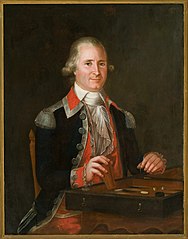|
José Francisco Xavier de Salazar y MendozaJosé Francisco Xavier de Salazar y Mendoza (1750–1802) was a portrait painter from New Spain known for being the first painter of significance to work in Spanish colonial New Orleans, Louisiana.[1][2] BiographySalazar was born to Salvador de Salazar and Feliciana Ojeda y Bazquez on the Yucatán peninsula in Mérida, Mexico.[3] He attended the Academy of San Carlos in Mexico City. In 1782, he moved to New Orleans with his wife, Maria Antonia Magaña (d. 1793) and their two children, a son, José, and daughter, Francisca de Salazar y Magaña, both of whom became artists. Shortly after moving. they had another son, José Casiano. In 1788, their home was destroyed in a fire, and the family moved into a church building. In 1791, the family was living on St. Philip Street, near St. Louis Cathedral, where their youngest son, Ramon Rafael de la Crus, was born.[1] Salazar died on August 15, 1802.[4] WorkSalazar is considered the foremost painter in Spanish Colonial Louisiana.[4] He painted the portraits of many prominent citizens of colonial Louisiana, including members of the church, government and the military. Some of his well-known sitters include Marianne Celeste Dragon, Don Carlos Trudeau Laveau, Joseph Montegut, Ignacio Balderas, Don Almonaster y Rojas, and Bishop Luis Ignatius Cardenas y Peñalver, among others. His paintings are in the late Baroque style that was favored in Spanish colonies[1] and show the influence of Mexican provincial styles.[4] The art historian Judith Bonner believes that Salazar's daughter Francisca worked with him due to certain drawing and painting inconsistencies found in his work.[4] His use of transparent glazes and dark backgrounds has been compared to Goya.[4] CollectionsSalazar's work is held in many museums. It is included in the Louisiana State Museum collection,[1] the Newcomb Art Museum collection,[5] Worcester Art Museum,[6] and the Historical Society of Pennsylvania,[7] among other institutions. Gallery
References
Further reading
|






